Two empowering women, Pratima Pandey and Rahini Ahuja, who represent the need for both practicality and reviving handlooms make the perfect opening for LMIFW SS’20 Read more
#LMIFW
Small towns, big stories
From a village, then Gurukul to finally fulfilling her childhood dream of becoming a model, Reeta Gaur hopes to emulate her Bareilly-raised idol, Priyanka Chopra Read more
Sun is also a star
Evoking Herve Leger’s spirit in his offerings, debutant Sameer Madan hopes to revive the bodycon dress which has been abandoned, with his line “Entrapment” Read more
Hide and Seek
Neha met Pranav and there was an invisible ‘cord’ that bound them to create leather accessories and easy clothing
Theory of Harmony
Bindu and Surya, mother-son duo combine music, engineering and physics to create a line that celebrates tradition, minus the jazz
By Asmita Aggarwal
You could call him the prodigal son, the one who stumbled into fashion, seeing the silent, but evocative efforts of his mother. Mother-son make the best pair, emotionally and commercially too as they balance ideas creating a chord wheel where effective notes bounce off.
That’s the story of Bindu and Surya Giri from Chennai of the label SGBG (symbolic of their names). Bindu from the royal family of Northern Kerala, has been working with textiles for the last 15 years, taking up languishing looms and reviving lost crafts. Masters in business administration from Chicago, Bindu adopted the family legacy of working with craftsmen from her village. Very few connoisseurs of the real art of traditional saris want to pay for authenticity; so she found devotees in UK and South Asia. “The family was in tandem with the traditions of yore and believed in protecting heritage, my mother was passed on the baton and she carried it bravely till the finish line,” explains Surya.

Surya, studied music and economics at the University of Chicago and graduated two years ago. He had no idea what the business entailed or ever dreamt of joining his mom. But it did happen almost serendipitously. While making a documentary for the BBC, he had a day off and decided just spontaneously to visit the looms under his mother’s care. “I was blown over and as my mother has always been so low key, I didn’t know the extent of her intervention. Though what made me want to join is, it was connected to my roots and design in modern times is more than what meets the eye; there are many subterranean layers which are intangible,” he explains.
History has been coded in the warp and weft of the ensembles and the duo took up the onerous task to elevate these art forms. The wheels got kicking and they went for the Paris Fashion Week (Tranoi Week) to participate in the sustainable edit, hoping to curate weaves in a contemporary form.
Literally born with a diamond spoon, Surya’s father was the VP Accenture, and his maternal grandfather Nandkumar was a respected royalty in Kerala, both families appreciated art, culture, fashion and music and the same genes were passed on to the subsequent generations. “Poetry exists in Indian textiles and we must create a cocoon around it to preserve it. Fashion has so many interesting stories sewn in its fabric that as designers we try and present them in the ten minutes we get on the runway,” he smiles.
Just like music, Surya says where rhythm and balance is the key to hit the right notes, in design you need an eye that looks beyond just colours and ornamentation. “We did a more densely packed version of the Kanchivaram and our version of the Banerasi weave, when it migrated down South got greater intricacy and was incredibly textured,” he admits.
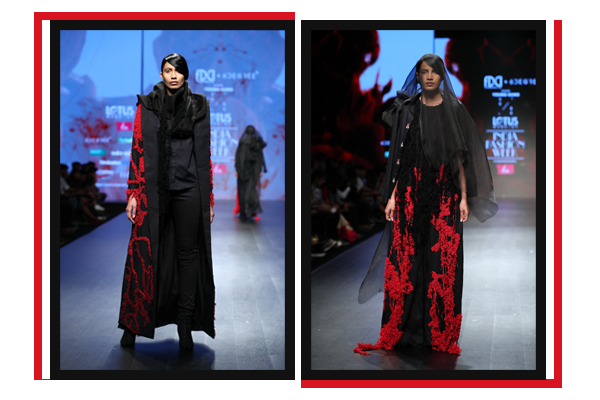
Fashion is more visual now and about fearless concepts and ethics and less about shapes and form. “I view our brand as an art project that’s why our LMIFW’19 showing has sculpture, drape and embroidery amalgamated in its foundation. Our clothes are global, they can be worn anywhere from Los Angeles to Kochi,” he concludes.
Backstreet Boys
Finally men strutting on nothing less than late Prince’s everlasting number Cream….a break from a sea of dresses, came some abs and toned muscles, as stripes and checks played truant with a generous dollop of Bollywood
By Asmita Aggarwal
It was the perfect song to play in the background—– Rolling Stones’ 60s number I can get no satisfaction with the inimitable Mick Jagger and Keith Richards, seemed it was well-chosen seeing the response of the female gender on the last day of the fashion fiesta.
What happens when there are catcalls, applause and intermittent giggles as an army of washboard abs take on the runway? Well… a barrage of smartphones rise up. Then you know it is the menswear show, the most awaited one at the LMIFW’19. The reason is apparent!
This year too, a bevy of beautiful broad shoulders descended on the runway, and among those were Aparshakti Khurana, the brother of the more popular Ayushman, the man who sang Paani da and made us all swoon. And representing a woman with intellect and of course everyone’s pride Guneet Monga, the one who got us the Oscar for the documentary Period. They walked for Rohit Kamra and his Maharaja-style ensembles soaked in the spirit of Rajasthan’s erstwhile royalty.
“I have explored the classic black and white palette, and in the middle fall greys and beiges. Traditional mirror work is the collection’s high point, inspired by the work done in many regions of Rajasthan. We’ve also explored coral, colour of the season, in accessories. As you can see, we have used semi-precious coral coloured stones as buttons on the jacket that Apar (Aparshakti Khurana) is wearing and handcrafted roses in the same shade, on the jacket that Guneet wears. The fabrics come from the loom of the weavers,” says Rohit.
Rohit has known Guneet for a long time now, and believes she has made the country proud. “I have been a small part of that journey just by observing what she is doing, and how. Apar and I have been great friends, and are related as well. He is on his way towards making it big on 70MM,” he adds.
The emergence of pleating and the Patiala shalwar was an interesting addition in the show with mirror work on handloom sherwanis, white winning the favourite race.
“I like Rohit’s style. He gives an uber modern touch to royal classics like this outfit uses a Western fabric that is velvet, and meets an Indian fabric which is khadi. Not very often do you see this concoction. You can see that variance in the people affiliated also, Guneet congratulated me for a nomination and I told her, ‘dude, you got an Oscar’,” says Apar.
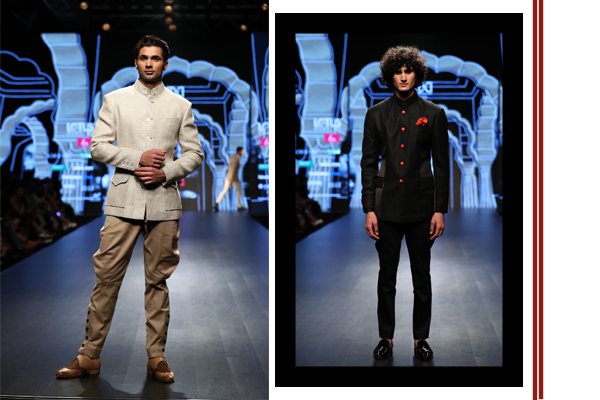
The star of the day was undoubtedly Guneet who candidly explained that working in the film industry, you start with the hopes that one day you will win an Oscar. “I never thought I would walk the ramp. I think what unites the three of us is that we are very rooted, ‘zameen se jude hue insaan hai’, that’s why we all connect. The center point is where we all come from, our journey and upbringing and we’re rooting for Rajasthan’s ethos,” says Guneet.
Guneet explains how she has been to the Mecca of celebrating design—Oscars entering the place with eyes wide open, looking at so much creativity. “I felt the same way coming here, looking at everyone – even the assistants running around with little hints of blue in their eyes and a pinch of sparkle on their nails, it was just a reminder that there is so much inspiration all around. So yes, we all follow the awards and all of them are celebrations of creativity more than anything. So today, for a person like me, being 5 feet nothing and standing there in all the power and walking the ramp was magical,” she laughs.
Menswear, a now growing genre, has more scope for experimentation, unlike women’s wear, a rather saturated space. That’s why you could see checks, stripes, tie ups, and tangerine peeking out of a grey base in Pawan Sachdeva’s offerings along with zippers oddly placed.
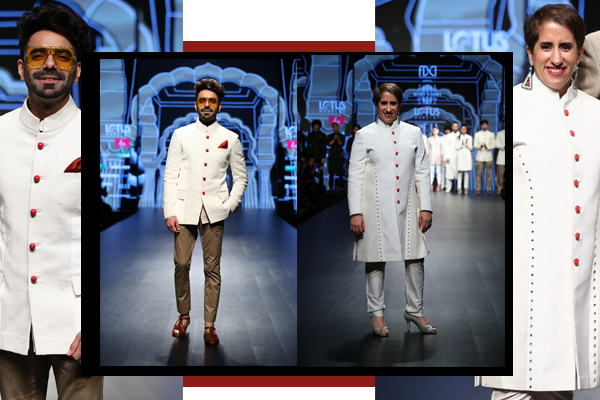
Interestingly, small is now becoming big it the world of fashion, with two pint sized bombshells taking on the runway—- Radhika Apte, the new North Star of many offbeat, non-commercial actors. The pant suit is now officially cool, and both designers proved you don’t need a man anymore to be a showstopper for menswear, women are the best ambassadors, as wardrobe distinctions merge to create a more unisex, androgynous appeal.
Day 3 : Hair and Make up
From Pallavi Mohans ‘70s sparkle to Namrata Joshipura’s futuristic vision, day 3 of fashion week witnessed hair and make up looks that pushed the boundaries and were an experimental departure from the norm.
Pankaj and Nidhi
The designer duos love for art transcended their showcase which was inspired by Dutch artist Jan Davidz de Heem’s Still Life with Flowers in a Glass Vase, and translated into masterful hair and make up.
A thin stroke of black eyeliner added intensity to a shimmering silver base accompanied with voluminous eyelashes to create a dramatic eye. Glistening against the soft lights as models walked down the outdoor plaza was dewy skin, pink sheen lipstick and slicked back and sculpted hair.
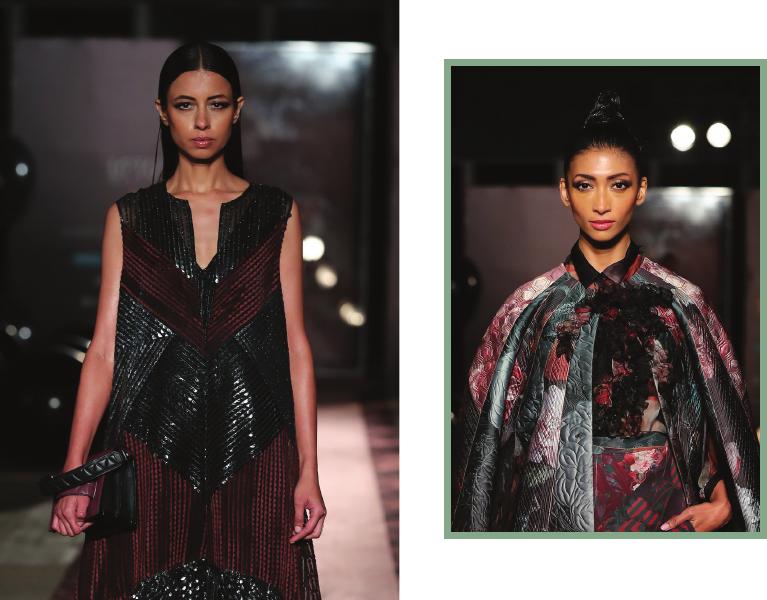
PC Diya Mathur
Rabani & Rakha and Vineet Bahl
From Vineet Bahl’s “Safari Soiree” to Rabani & Rakha’s ultra glamour, hair and make up was skillfully crafted to complement collections that were on two ends of the spectrum. Hair was side parted and gently placed over the shoulder, in soft waves to add to the natural effect. Soft eyeliner blended into the eye, and was paired with contouring which added to the dimension of the face. Variations in lip colours, from a pale sheen pink to matte black completed the look.

PC Diya Mathur
Namrata Joshipura
Glittering tear ducts and iridescent eyelids added to Namrata Joshipura’s ultra glamorous collection that was showcased on an electric runway. Precise contouring and an intense highlight was applied to a perfect base, and completed with a burgundy lipgloss that contributed to the shine. Hair was side parted and neatly tied, in sync with the look of sophisticated glamour.
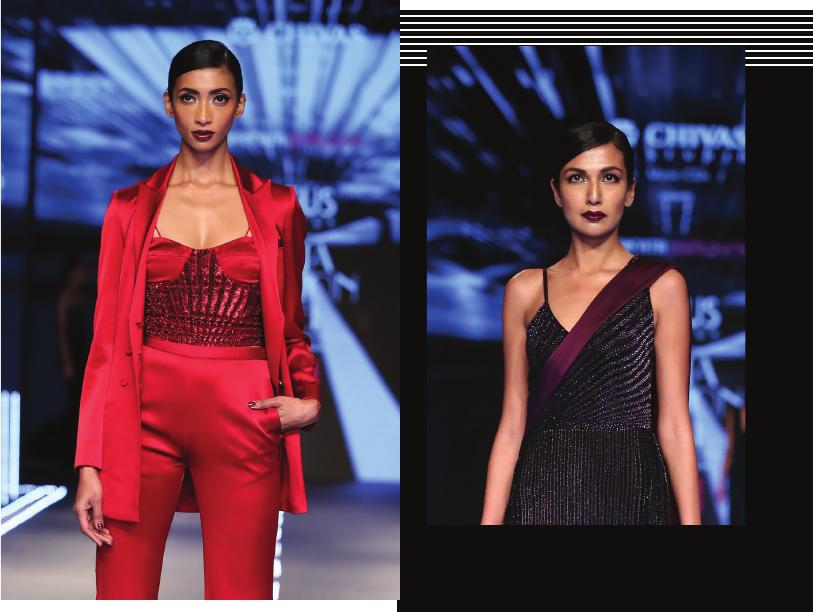
PC Diya Mathur
Ruceru, 17:17 by Simmi Saboo, Tisharth by Shivani Jain and Ashwini Reddy
Glittering was the need of the hour, as the showcase featured golden eyelids and lips washed with an electric pink sparkle.
Balancing the shine was a classic contour, and strobing on the high points of the cheek, bridge of the nose and the cupids bow. The hair was subtly straightened and parted from the side for a look of modern opulence.

PC Diya Mathur
Charu Parashar, Dolly J and Ekru
A versatile cat eye, flawless skin and centre parted hair, slicked back and tied, was the apt way to unify Charu Parashars street style, Dolly J’s high glamour and Ekru’s simple vision.

PC Diya Mathur
Aarti Vijay Gupta and Amrich
What unified Aarti Vijay Gupta’s floral fiesta with Amrich’s homage to the 80s rock and roll era was a voluminous hairdo, braided from the front and blended into a large puff, that was left open and teased at the back.
What varied however, were the lip colours for two completely contrasting collections. A tone of salmon on the lips for Gupta’s showcase complemented her bright vision, whereas black added an element of grunge to Amrichs showcase.
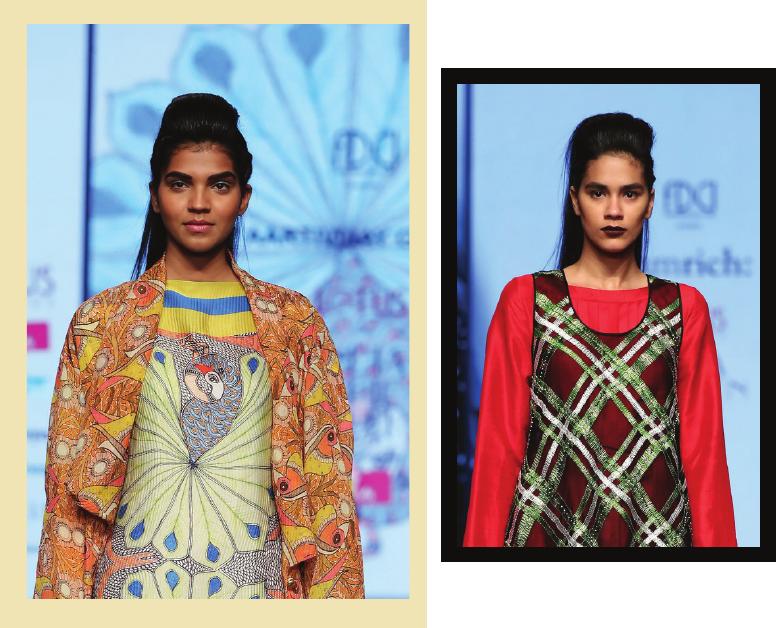
PC Diya Mathur
Pallavi Mohan
Hair and make up took direct inspiration from the glamour of Manhattans nightclubs and discotheques, evoking a sense of extravagant and hedonistic style. Illuminating the face was highlighter, applied on the high points of the cheek, brow bone, bridge of the nose and the cupids bow. Darkened eyebrows and a smoky eye along with subtle puff and slicked back hair brought back the 70s in style.

PC Diya Mathur
Let’s go Dutch
Dutch architecture has remained etched in the memory of Pankaj and Nidhi, as they revisit past classics and romance the present with new surface techniques
By Asmita Aggarwal
Sometimes you have to let go of the past to enable a better future and that’s just what Pankaj and Nidhi did this season. Abandoning appliqué their all time favourite, and moving on to hand-crafted, interesting surfaces, P & N take up ribbons. They attempt fringing with it and elevate it to a new level by adding scallops.
The beauty of the label is how they start from the sourcing stage, where metallic sheets are cut according to unpredictable shapes giving the ensembles a fresh dimension. This year, they have revisited what they did almost 10 years ago in 2008, when they were in the fashion incubator, attempting to make a place for themselves in the design sphere.
Trapunto, or the Italian stitch is mostly used in quilting, a process the duo loves (both the quilts and the technique). This season, it is back, not a solid base, but executed on prints. Memory and fashion has a direct connect, even though this may not be Freudian, as both don’t fail each other, maybe that’s why the husband-wife team’s visit to Netherlands Rijks Museum where Rembrandt to Franz Hals reside visually, left a lasting impact on them. That’s why the quilting found a rather unseemly soulmate—- graphic art inspired by the artworks they appreciated.
Understanding sustainability is the need of the hour, they source ethically and now have endeavoured to work with vegetable dyes. Though it is a misnomer they don’t include textiles, their Chanderi striped ensembles are a sold out in their boutiques and their design intervention in Benerasi is quite well…cool. “Instead of the regular gold we worked with silver yarn and added rose motifs on the weave,” says Pankaj. For their Paris outing, they did revisit appliqué but not in neoprene or patent leather rather in velvet that had this malleable mushiness.

Experimentation remains the basis of the label, even though they are lovers of new-age technology, fine mill-made yarns as well as laser cutting. “We try and do our bit to ensure zero waste, so the laser cut waste is again refashioned into jaalis, which we use as adornment,” he explains.
Twelve years ago when P & N began, they were intrepid, created with abandon, now that kind of has been overtaken by the need to survive in an industry that is unforgiving to those who aren’t updated. “It is a challenging time but creativity is never going to be passé,” says Pankaj.
The change that he sees, is there are lesser flights of fancy in fashion, it is more pragmatic, easier, less restricting and also about missing and matching, coordinates and separates. “It is less about brands now but more about looking for unique pieces that’s why, people are scouting flea markets and vintage shops looking for that novelty,” he adds.
P & N’s survival kit is pretty simple— give the West what it can’t do, beautiful embroideries; so there can be a crewel work bomber jacket, or an aari work blouse, the Parisians love, as tailoring they are masters at. Diversity is the foundation of their label, so you can see both a handloom fabric and polyester mesh exist hand-in-hand in their repertoire.

Social media has changed the paradigm, its reach has impacted many businesses and even though Nidhi, now a mother-of-two Laila, 6, and one-year-old Vir, took the lead and started it, four years ago, their followers have grown organically. “It is a great way to put your brand out there, even though none of us, have personal accounts,” says Pankaj.
Four times a year in Paris can be exhausting, and even though when they went there for the first time they felt a bit lost in a sea of heavy red carpet looks, soon their found their niche. “Brand extensions excite me, I want to do something in the area of home; soft furnishings, the whole nine yards is what I would I like to offer in a few years,” he signs off.
Mind Gym
Soul surfer Namrata Joshipura lights up the ramp with her shine and offers youthful classics that will withstand the time and tide
By Asmita Aggarwal
In the skyline, parks, flyovers, nightlife to the streets, each element of New York, has found an interesting representation in Namrata Joshipura’s catwalk renditions. The city and its character have become ingrained in the designer’s DNA, maybe because she first moved there with her chartered accountant husband, and hedge fund manager, Vivek, and started her foray into fashion, or just the gilt-edged life was so mesmerising that it is tough to shed, even after 20 years. Vivek now manages her accessories like NamJosh, which he is independently handling along with the business development and finance of the entire brand.
For two decades, Namrata had had a rather long love affair with embellishments, all kinds, shapes and sizes, quite different from her batchmate and contemporary at NIFT (Delhi) Rajesh Pratap Singh. Maybe a bit tired of the ubiquitous tag ‘fashion designer’, few know that Namrata first started working with Suneet Varma. She also did costumes for a film Dance of the Wind, by an NID educated filmmaker. “New York and I have had a rather interesting relationship. I run marathons and my first world major was in New York; my daughter now 14, was born there, I still go back and forth there; frankly there are so many connections that it is almost developed into a bond,” she adds.
New York’s energy stayed with Namrata that’s why jumpsuits have become her best selling item and brocade, her new found obsession, even though it is a bit too traditional to fit into her scheme of high-voltage things. “I like the veracity of both ikats and brocades, one is floral and the other geometrical,” she explains.
A feeling, moment or observation becomes the ignition point for Namrata, not art or architecture and the saying “One eye feels, another one sees,” by Paul Klee kind of fits perfectly in her aesthetic. “The genesis of a line can be anything from sequins, matte, shine, weaves to flowers. It has to be something that inwardly made an impact on me,” she explains.
That’s why, this season, the collection is an amalgamation of calm, yet it remains fashion-forward, with stripes and glitter, in what you could call evening wear ensembles, which are guaranteed to make a woman feel fabulous. Even though the world may be moving towards a new era of minimalism, a Namrata customer loves her shine. “After all Valentino made Isha Ambani’s lehenga. There are enough people embracing ornamentation,” she smiles.

In a world that abandons and picks up trends according to what sells, Namrata has stayed true to her brand’s DNA. Subdued bling, surface treatments and bodysuit, and being able to wear an outfit you bought ten years ago is what has kept the otherwise reticent designer relevant in modern times.
In tune with what young women desire, and being an avid sportsperson, Namrata is looking for effective collaborations. From Adidas where she restyled their Stan Smiths, she is looking at offering a line of active wear, something she understands and somewhere she can put in her design prowess to good use.
Glamour whether it was Princess Diana, Marilyn Monroe to Jackie Kennedy has always found supporters in history and even now, Namrata says it is this need to look beautiful is what gave rise to today’s airport looks. “People are not going to stop looking beautiful and if my silk georgettes, crepes and chiffons can add to the magic, why not?” she explains.
The LMIFW’19 line has a youthful vibe, but the future for Namrata will be taking a deeper dive into textiles. She did flirt a few years ago with brocade, designing an envy-worthy jumpsuit. “I enjoyed working with brocade, now I need to do more experiments within this genre. Everyone is talking about sustainability, I think more than using fabrics which are organic you should also learn to mix and match your old classics and give them a new feel, that will be a true contribution to a better future,” she concludes.









